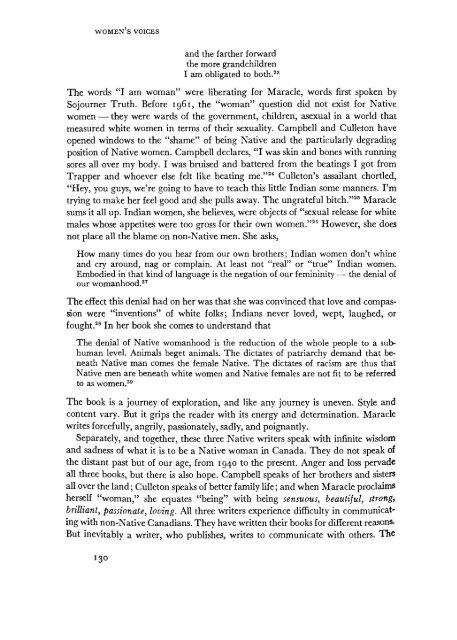CONTEMPORARY NATIVE WOMEN'S VOICES IN LITERATURE
CONTEMPORARY NATIVE WOMEN'S VOICES IN LITERATURE
CONTEMPORARY NATIVE WOMEN'S VOICES IN LITERATURE
Create successful ePaper yourself
Turn your PDF publications into a flip-book with our unique Google optimized e-Paper software.
WOMEN S <strong>VOICES</strong>and the farther forwardthe more grandchildrenI am obligated to both. 23The words "I am woman" were liberating for Maracle, words first spoken bySojourner Truth. Before 1961, the "woman" question did not exist for Nativewomen — they were wards of the government, children, asexual in a world thatmeasured white women in terms of their sexuality. Campbell and Culleton haveopened windows to the "shame" of being Native and the particularly degradingposition of Native women. Campbell declares, "I was skin and bones with runningsores all over my body. I was bruised and battered from the beatings I got fromTrapper and whoever else felt like beating me." 24 Culleton's assailant chortled,"Hey, you guys, we're going to have to teach this little Indian some manners. I'mtrying to make her feel good and she pulls away. The ungrateful bitch." 25 Maraclesums it all up. Indian women, she believes, were objects of "sexual release for whitemales whose appetites were too gross for their own women." 26 However, she doesnot place all the blame on non-Native men. She asks,How many times do you hear from our own brothers; Indian women don't whineand cry around, nag or complain. At least not "real" or "true" Indian women.Embodied in that kind of language is the negation of our femininity — the denial ofour womanhood. 27The effect this denial had on her was that she was convinced that love and compassionwere "inventions" of white folks; Indians never loved, wept, laughed, orfought. 28 In her book she comes to understand thatThe denial of Native womanhood is the reduction of the whole people to a subhumanlevel. Animals beget animals. The dictates of patriarchy demand that beneathNative man comes the female Native. The dictates of racism are thus thatNative men are beneath white women and Native females are not fit to be referredto as women. 29The book is a journey of exploration, and like any journey is uneven. Style andcontent vary. But it grips the reader with its energy and determination. Maraclewrites forcefully, angrily, passionately, sadly, and poignantly.Separately, and together, these three Native writers speak with infinite wisdomand sadness of what it is to be a Native woman in Canada. They do not speak ofthe distant past but of our age, from 1940 to the present. Anger and loss pervadeall three books, but there is also hope. Campbell speaks of her brothers and sistersall over the land ; Culleton speaks of better family life ; and when Maracle proclaimsherself "woman," she equates "being" with being sensuous, beautiful, strong,brilliant, passionate, loving. All three writers experience difficulty in communicatingwith non-Native Canadians. They have written their books for different reasons.But inevitably a writer, who publishes, writes to communicate with others. The130

















